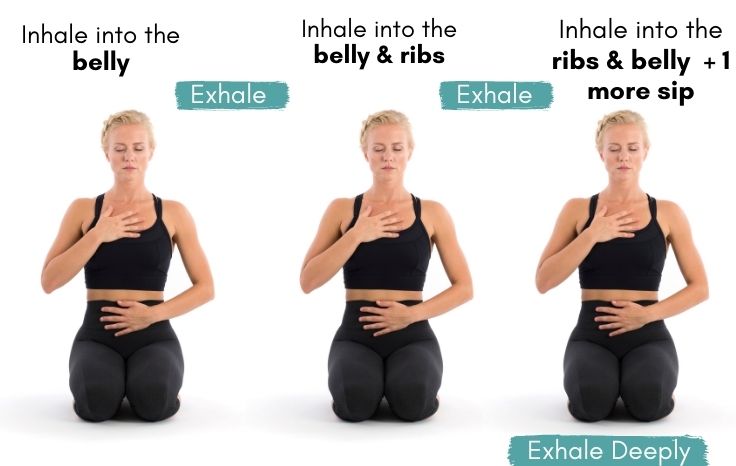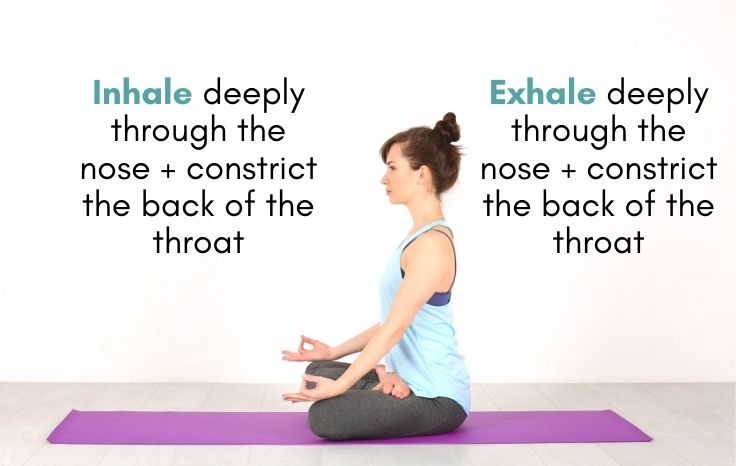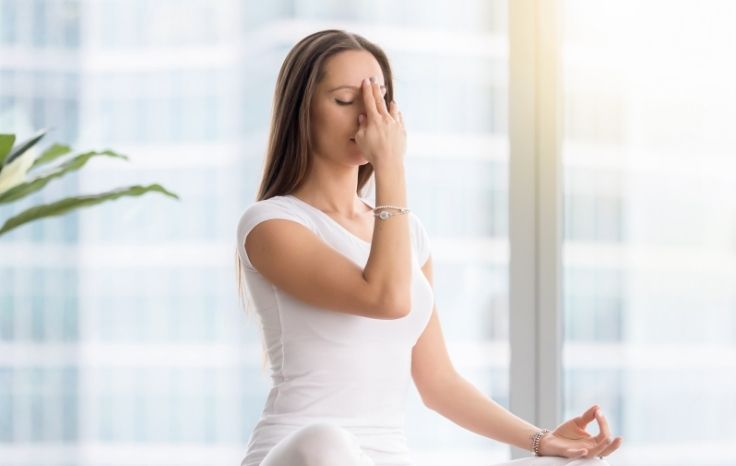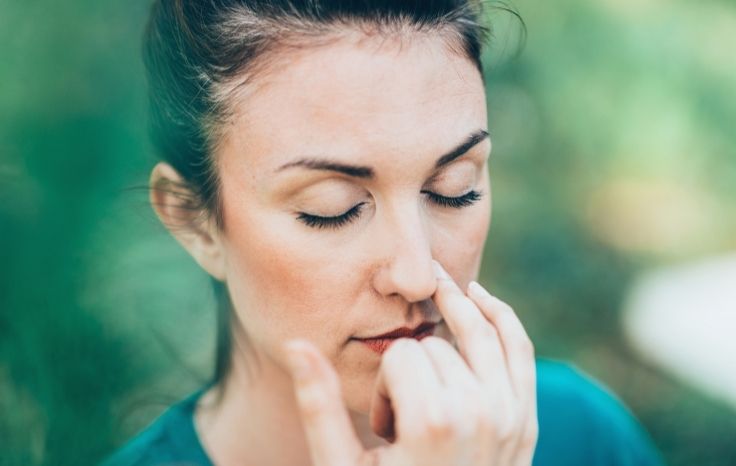We all know that breathing is necessary in order to live. But did you know that controlled, deep diaphragmatic breathing not only reduces stress but can improve lung, cardiovascular and overall health? Practicing pranayama techniques for beginners is essential not only to cultivating a strong yoga asana practice. It’s important for our overall physical and mental health.
Table of contents
What is Pranayama?
Pranayama is the sanskrit word for the practice of controlled breathing done either on its own or during your yoga asana practice.
Broken down, pranayama is the combination of the words “prana”, meaning energy or life force, and “ayama” meaning to extend or draw out.
Prana is the energy that keeps us alive. It is the force that propels our physical and subtle bodies. Without prana we would cease to exist.
By developing a pranayama practice we can begin to break away from our unconscious breathing practices and develop a pattern of smooth and long breath.
Most of our unconscious breathing patterns are often shallow and quick. This shallow and quick breathing can impact our stress levels and our overall health. Developing a smooth and extended breathing practice brings relaxation, has a positive impact on our nervous system and can improve our health.
How often have you heard during a stressful time to “Take a deep breath”. That deep breath helps to focus your mind and release some tension.
Or when you are frightened you quickly gasp for air.
The key to understanding the power of breath can be found in scientific research.
The Science Behind Pranayama Practice
Our autonomic nervous system is the part of our nervous system that controls the functions of our organs and glands and is made up of the sympathetic nervous system and the parasympathetic nervous system. When these two systems are out of balance for too long it can have a negative impact on our overall health.
When we become stressed our sympathetic nervous system goes into what is often known as “fight or flight” mode. This includes increased heart rate and rapid breathing. Being in this stressed fight or flight mode for prolonged periods of time can have dangerous impacts on our health. By slowing our breath down we can activate our parasympathetic nervous system which helps the body relax after a danger or stressor has passed and bring these two systems back into balance.
Long and controlled breathing for an extended period of time, even just two or 3 minutes, can have real benefits to our health beyond just our level of stress.
According to a May 2020 article published in the International Journal of Science, current research indicates pranayama has a positive impact on “patients with respiratory diseases such as bronchial asthma. It also helped those with cancer and cardiovascular disease.”
Ready to start reaping all the benefits of a pranayama practice?
How to Begin a Pranayama Practice
The idea of practicing breathing might seem silly at first. I mean, we all have to breathe in order to live. But once you have begun to incorporate pranayama techniques into your life and your yoga asana practice you will learn to appreciate the impact of this deeper conscious breathing.
Here’s how to get started:
Come to a comfortable position, either seated or laying down, and begin to notice your breath. No need to do anything special at this point. Are your inhales and exhales even? Does your chest rise as you inhale? Does your belly feel when you breathe? There is no right or wrong answer.
Next, try to take long deep breaths filling the belly and lungs and then exhale deeply. How do you feel after taking a few deep breaths? What happened within your body during these deep breaths? Did your shoulders relax? Did you sit up taller? Again, there are no right or wrong answers here.
Try this a couple different times throughout the day and take some notes with your observations. Perhaps you notice your breath is slower in the morning and by evening it’s much more rapid or shallow.
Bringing awareness to our regular breath is a great way to notice the impacts of of pranayama techniques.
4 Pranayama Techniques for Beginners
Once you’ve got the hang of noticing your breath you can begin to try some different pranayama techniques. These pranayama techniques for beginners are simple ways to develop a deep and calm breath.
Most of these breathing techniques require inhaling and exhaling through the nose. Breathing through the nose invites a deeper diaphragmatic breath, meaning it uses more of your diaphragm and brings more oxygen into your system.
If breathing through the nose is uncomfortable because of allergies or other sinus disruptions you can still practice most of these techniques by breathing through the mouth.
Box Breathing
This is the simplest breathing practice and by far the best pranayama technique for beginners. It focuses on creating an even breath while requiring the practitioner to develop a strong sense of control.

- How – Inhale through the nose as you count to four. Hold your breath for a count of four, exhale for a count of four, hold for a count of four. Repeat at least three times.
- When – This technique can be done anytime. For more relaxation stick with a 4 count breath. For a more energizing pranayama practice count to six.
- Why is this good for you – While there isn’t a ton of research specifically into the benefits of box breathing, this pranayama technique is a great way to develop deep breath awareness.
Three Part Breath (Dirga Pranayama)
This is another very simple breathing technique perfect for beginners. It is a purifying and energizing breath that focuses on taking complete breaths. It helps to explore the full depth of our breath.

- How – Sitting comfortably, place one hand on your belly and one hand on your chest. Begin by inhaling through the nose and filling the belly. Exhale. Take three more breaths like this. Inhale again, filling the belly and expanding the inhale to fill the ribs. Exhale. Take three more breaths like this. On the next inhale, fill the belly and ribs completely. At the top of the breath (or right before you exhale) take in one more sip of air. Exhale deeply and fully through the nose. Repeat as many times as feels good.
- When – This breath is appropriate anytime of the day. It is often used at the beginning of a yoga practice to help get centered and ready for meditation.
- Why– The practice of deep diaphragmatic breathing increases oxygen levels even if done just a few times. It also helps us to stay grounded in the present moment.
Ujjayi Breath
This is the most common pranayama technique used during yoga asana practice. It is sometimes call “Darth Vadar Breath” because a slight constriction in the back of the throat creates an audible breathing sound just like Darth Vadar. This pranayama technique helps to build heat in the body.

- How – Coming to a comfortable seat, begin by this practice by quietly whispering the sound “HAAAH” with the mouth open as you inhale and exhale. Next close the mouth while continuing to create the “HAAAH” sound. You will feel a slight constriction at the back of the throat.
- When – This practice can be done on it’s own or it can be done throughout your yoga asana practice to help bring awareness to your breath.
- Why– According to this article in the Journal of Alternative and Complementary Medicine, ujjayi breath “can alleviate anxiety, depression, everyday stress, post-traumatic stress, and stress-related medical illnesses”.
Nadi Shodhana (alternate nostril breathing)
In sanskrit nadi shodhana means subtle energy clearing technique. This is a simple yet effective calming and energy balancing pranayama practice.

- How – Come to a comfortable seated position. Bring your right hand up to your face and place your pointer and middle fingers lightly between the eyebrows. They will serve as an anchor. The thumb and ring finger will be the active fingers. Take a deep breath in and out. Close your right nostril with your right thumb and inhale deeply. Use your right pointer finger to close your left nostril, release the right thumb to open the right nostril and exhale. Next, close the right nostril with the right thumb and release the right pointer finger from the left nostril and exhale. Close the left nostril with the right ring finger release the right thumb from the right nostril and exhale. Repeat 5-10 times.
- When – This is a calming breath that can be done at the beginning or at the end of a yoga asana practice. It is also great to help get grounded during stressful times. Try Nadi Shodhana before a big presentation your nervous about and notice the benefits!
- Why – Practice Nadi Shodhana supports clear and balanced respiratory channels, relieves stress and anxiety, and has a balancing effect energetically on the body and mind.
Before you begin your pranayama practice
- Never force the breath. Go slow. Your breath practice will develop over time. Don’t force additional rounds of breath if it feels uncomfortable. If you become lightheaded or intolerable stop the breathing practice and return to your normal breath.
- Patience. Your breathing practice will develop over time. Be patient with yourself and understand that just like any other form of exercise, exercising our breath requires time and effort.
- Precautions. As with any new practice, always consult with a physician to make sure these breathing techniques are safe for you. If you are pregnant, have diabetes, low or high blood pressure or other heart conditions it is especially important to consult with your physician before employing these breathing techniques.
Looking for to build an at home yoga practice? Check out these videos an tips to help build your practice.
